SIGGRAPH 2007
by Fred Thorlin
SIGGRAPH began as a Special Interest Group of the ACM, Association for Computing Machinery, when computer graphics attempted to create discernable images on plotters. They were clever, but a far cry from today’s photo-realistic, anti-aliased, and anisotropic computer-generated images produced for games in real-time or as feature films. Since these productions are currently out-grossing the works of George Clooney and friends, game developers are being actively pursued. The annual SIGGAPH conference now yields about 20% of its floor space to industry recruiters, e.g. AutoDesk, AMD, Pixar, LucasFilm (ILM), et al. The recruits are the products of well over one hundred schools nationally including, Art Institute of Houston, HCC, Sam Houston State and U of H-Victoria in the Houston area. Starting salaries range from $30,000 to $60,000 a year. Candidates from across the country and around the world were attracted to San Diego for the conference with an outstanding exhibit of eye candy, tools, talks, toys and opportunities.
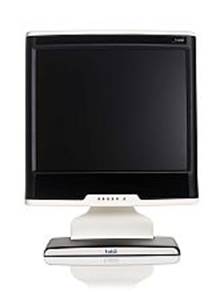 For me the main show is in the booths. Here I get to explore the latest technologies. The first one to impress me was from Sweden. Tobii.com makes an eye-tracking system integrated into an LCD display. After a brief calibration exercise they can determine where you are looking sixty times a second as you view the screen, typically an advertisement. How much time is spent looking at the beautiful model before you wander over to the product? What parts of the product attract your interest? After showing the sequence of images/ads to a group of people, they produce excellent graphical reports of how people visually interact with the advertisement allowing their customer to tune the ad. The units with software are available for purchase or rent. For me the main show is in the booths. Here I get to explore the latest technologies. The first one to impress me was from Sweden. Tobii.com makes an eye-tracking system integrated into an LCD display. After a brief calibration exercise they can determine where you are looking sixty times a second as you view the screen, typically an advertisement. How much time is spent looking at the beautiful model before you wander over to the product? What parts of the product attract your interest? After showing the sequence of images/ads to a group of people, they produce excellent graphical reports of how people visually interact with the advertisement allowing their customer to tune the ad. The units with software are available for purchase or rent.
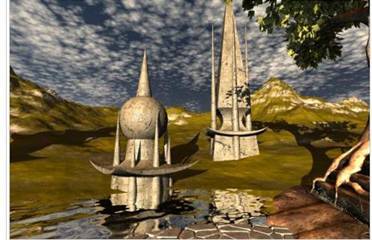 Most computer modeling programs cost thousands of dollars and take a great deal of effort to learn. For those of us who don’t want to cross those painful thresholds there has been Bryce 3D. Free updates of early versions are available from download.com. After passing through the hands of several publishers, Bryce is now in the hands of DAZ3D.com and the latest version is Bryce 6. Bryce 6 costs less than a hundred dollars. It includes multi-processor support and model importing from the DAZ large and economical model library. A compatible stand-alone modeling package, DAZ Studio, is currently available free from their web site. Most computer modeling programs cost thousands of dollars and take a great deal of effort to learn. For those of us who don’t want to cross those painful thresholds there has been Bryce 3D. Free updates of early versions are available from download.com. After passing through the hands of several publishers, Bryce is now in the hands of DAZ3D.com and the latest version is Bryce 6. Bryce 6 costs less than a hundred dollars. It includes multi-processor support and model importing from the DAZ large and economical model library. A compatible stand-alone modeling package, DAZ Studio, is currently available free from their web site.
Google was there showing off their 3D buildings in Google Earth, their free and awesome photo map of our planet. They just activated the buildings for San Diego where SIGGRAPH is held every other year; this one was attended by 24,000 people.
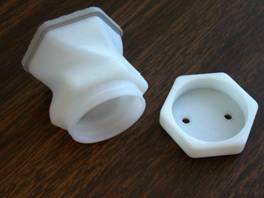 Three-dimensional printing is a growing element of graphics, but it doesn’t seem to be growing as fast as its technology is improving. Ten years ago the processes involved such corrosive materials that the printers required separate housing and hood-wearing operators, as well as six figure investments. Now you can buy a printer for under $20,000 that produces models from ABS plastic that runs in an office setting. DimensionPrinting.com had a couple of printers on the show room floor producing sample objects up to 10x10x12” in size to an accuracy of one hundredth of an inch. The multi-color threaded pieces pictured indicate current capabilities. They said several of their printers are now being operated out of garage-located service bureaus. Several booths were demonstrating modeling software pointed to creating solid models for these printers. Three-dimensional printing is a growing element of graphics, but it doesn’t seem to be growing as fast as its technology is improving. Ten years ago the processes involved such corrosive materials that the printers required separate housing and hood-wearing operators, as well as six figure investments. Now you can buy a printer for under $20,000 that produces models from ABS plastic that runs in an office setting. DimensionPrinting.com had a couple of printers on the show room floor producing sample objects up to 10x10x12” in size to an accuracy of one hundredth of an inch. The multi-color threaded pieces pictured indicate current capabilities. They said several of their printers are now being operated out of garage-located service bureaus. Several booths were demonstrating modeling software pointed to creating solid models for these printers.
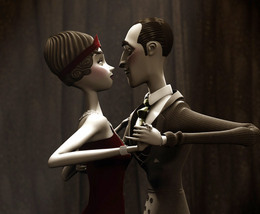 Each SIGGRAPH conference features the Animation Theatre. Here schools and professional computer graphics practitioners show off their cleverest materials. The clips, rarely lasting over two minutes, illustrate computational techniques, such as creating realistic movements of cloth and liquids, as well as story telling skills. This naturally includes previews of much-anticipated games such as Crysis which has dazzling physical effects, e.g. knock down a fence and the slats interact realistically. Typical of the videos shown, some of which are also available on the web, are “Human Snowball” www.metacafe.com/watch/251088/human_snowball/, “Respire, Mon Ami” www.respiremonami.com and the Award of Excellence winner “En Tus Brazos” www.youtube.com/watch?v=3PU5Tsx36E0 Each SIGGRAPH conference features the Animation Theatre. Here schools and professional computer graphics practitioners show off their cleverest materials. The clips, rarely lasting over two minutes, illustrate computational techniques, such as creating realistic movements of cloth and liquids, as well as story telling skills. This naturally includes previews of much-anticipated games such as Crysis which has dazzling physical effects, e.g. knock down a fence and the slats interact realistically. Typical of the videos shown, some of which are also available on the web, are “Human Snowball” www.metacafe.com/watch/251088/human_snowball/, “Respire, Mon Ami” www.respiremonami.com and the Award of Excellence winner “En Tus Brazos” www.youtube.com/watch?v=3PU5Tsx36E0
One thing I learned from watching the film credits is that multiple 3D modeling packages are normally used in the creation of each movie. Each of these has its own “standard” file format. The 3D modeling industry is “blessed” with more standards than you can count. Fortunately there is a translation package available, PolyTrans (okino.com), which will preserve work as the modeler moves from a program strong in fabric effects to another whose strength is volumetric effects, for example.
Another puzzle is “How is real video integrated with computer generated graphics?” A solution is provided by boujou 4 from 2d3.com. Boujou examines the source video and, by analyzing the manifest parallax, works out the precise track of the camera that took the real video. The track is then imported into the computer model so that its camera can follow exactly the same track making the combined scenes match up perfectly. There are even some features which help with handling the overlapping of real elements with computer generated ones.
My favorite low end 3D vendor is American Paper Optics, 3dglassesonline.com. They provide paper glasses that support viewing 3D images using a range of technologies at give-away prices. They offer the old red-blue anaglyphic glasses and the really cool Chromadepth glasses that convert colors to depth. Recently they introduced ColorCode which allows depth keying of normal appearing photographs. Their other big trick is to make text appear in a circle around points of light when viewed through their glasses.
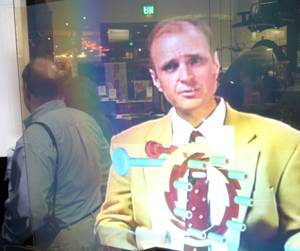 EON Touchlight is an interesting product in that it allows the observer to manipulate an image using their hands. EON eonreality.com showed several other unusual displays but it was the Holopodium that wowed me. This is a nearly transparent display on which life sized video images of people are projected. The opacity of the image and the transparency of the background sufficed to make it look like the speaker were present. He only lacked a certain depth, but that is common with sales presenters everywhere. EON Touchlight is an interesting product in that it allows the observer to manipulate an image using their hands. EON eonreality.com showed several other unusual displays but it was the Holopodium that wowed me. This is a nearly transparent display on which life sized video images of people are projected. The opacity of the image and the transparency of the background sufficed to make it look like the speaker were present. He only lacked a certain depth, but that is common with sales presenters everywhere.
SIGGRAPH had a very large international attendance, consisting of perhaps thirty percent of the exhibitors and attendees. With computer game sales exceeding movie box-office receipts, computer animation is an industry everyone is now interested in.
Fred Thorlin is a contract software developer with experience in compiler development now working with Visual Basic and Palm computer environments. He also writes columns on Visual Basic programming and computing on the road. He can be contacted at fredt@hal-pc.org.
|

